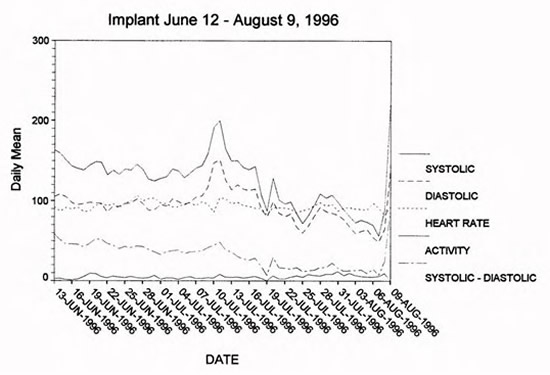Telemetric Monitoring of Blood Pressure , Heart Rate, and Activity in a Woolly Monkey (Lagothrix lagotricha) in a Zoo Setting
Abstract
Radio telemetry technology was applied in a zoo setting to evaluate blood pressure in woolly monkeys (Lagothrix lagotricha), a species with a high incidence of hypertension.1
Radiotelemetry implants (TA11PA-D70, Data Sciences International, 4211 Lexington Avenue North, St. Paul, MN 55126-6164, USA) were placed in two woolly monkeys at the Pittsburgh Zoo to measure blood pressure, heart rate, and activity using procedures previously described.2 For both monkeys, the catheter was placed into a branch of the femoral artery and positioned, so the catheter tip was in the femoral artery near the dorsal aorta. The body of the implant in the first monkey was placed subcutaneously over the caudolateral abdomen. The body of the implant in the second monkey was sutured to the body wall inside the abdominal cavity.
The implant in the first monkey failed, due to impact when the monkey was netted for evaluation of lameness in the catheterized leg. The implant in the second monkey became occluded with fibrin about 30–40 days after placement. Catheter occlusion occurred because the catheter tip was in the smaller femoral artery rather than the larger aorta.
An array of receivers (RLA 2000, Data Sciences International, 4211 Lexington Avenue North, St. Paul, MN 55126-6164, USA) was placed in the woolly monkeys’ holding area to allow for monitoring the animal in its normal setting. A computer and software program (Dataquest IV version 2.2, Data Sciences International, 4211 Lexington Avenue North, St. Paul, MN 55126-6164, USA) provided data collection 24 h/day at 20 sec intervals (Figure 1). Data was collected while the second monkey was under no treatment for hypertension and under propranolol treatment for hypertension (5, 10, 15, 20, 35, 30, and 35 mg PO BID). Propranolol doses were increased at 2-day intervals.
Figure 1. Radiotelemetry measurements on a woolly monkey

During 40 days of data collection in the second monkey, circadian rhythm of blood pressure, heart rate, and activity was demonstrated using a time series autocorrelation analysis and an independent two tailed student’s t test (SPSS 6.1 for Windows, SPSS Inc., 444 N. Michigan Avenue, Chicago, IL 60611, USA). No significant reduction of blood pressure with propranolol treatment at doses of [sic] was observed. Since propranolol is a well-documented antihypertensive drug, it is likely that occlusion of the catheter or other factors which impact blood pressure, influenced blood pressures recorded at the time of treatment with propranolol.
These results demonstrate that radiotelemetry technology can be used in a zoo setting to monitor blood pressure.
Literature Cited
1. Giddens, W.E. Jr., C.A. Combs, O.A. Smith, and E.C. Klein. 1987. Spontaneous hypertension and its sequelae in woolly monkeys (Lagothrix lagotricha). Lab. Anim. Sci. 37(6):750–756.
2. Sadoff, D.A., R.J. Fischel, M.E. Carroll, and B. Brokway. 1992. Chronic blood pressure radiotelemetry in rhesus macaques. Lab. Anim. Sci. 42(1):78–80.